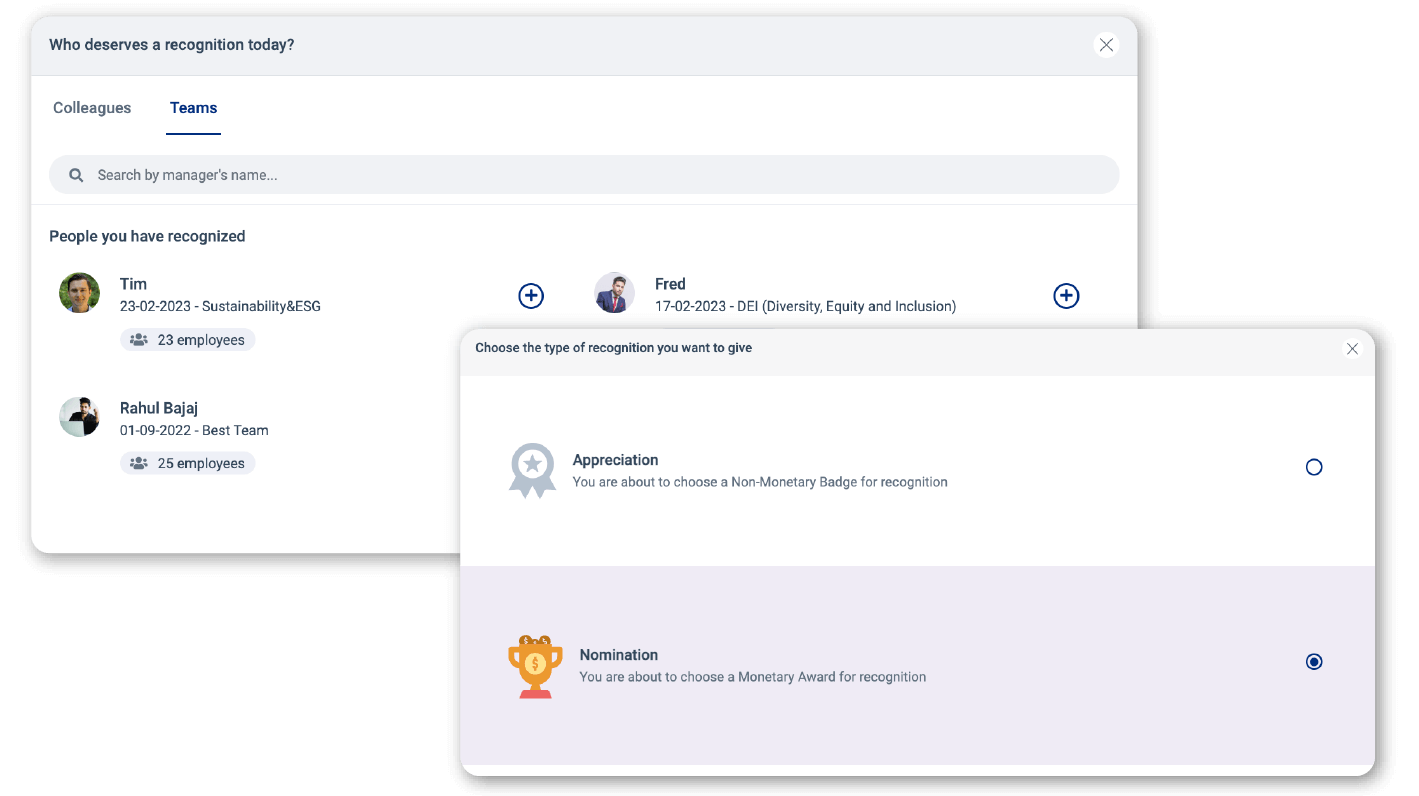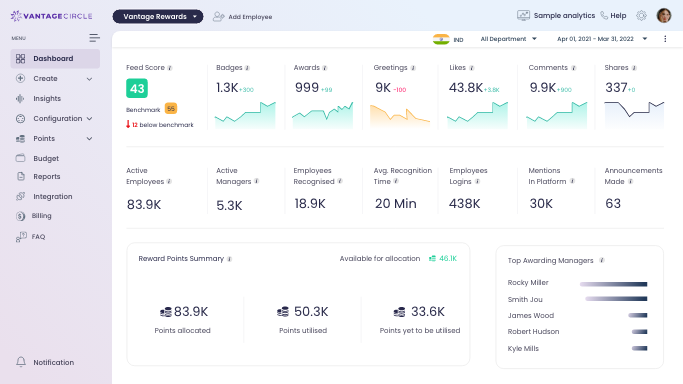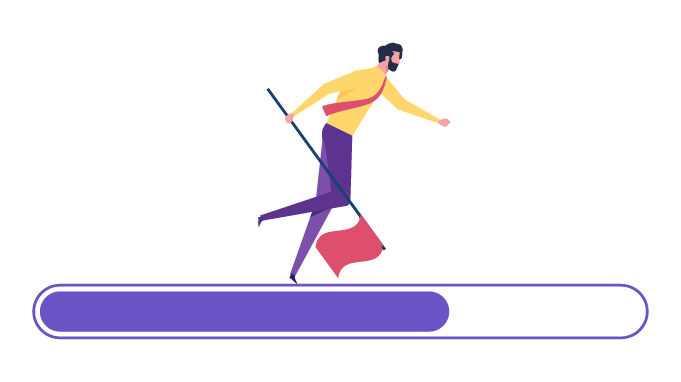7 Impactful Ways to Design a Team-Based Rewards Program
Teamwork is essential for achieving organizational goals and objectives in today's increasingly complex and interconnected workplace. However, while individual performance is frequently rewarded with raises, promotions, and bonuses, team performance is frequently overlooked or undervalued. But team-based rewards can fill that gap for an organization. It can foster a culture of collaboration, improve job satisfaction, and ultimately drive better business results by recognizing and incentivizing collective effort and success.
In this context, it is worthwhile to investigate the advantages and disadvantages of team-based rewards and best practices for designing and implementing them successfully.
What are Team-Based Rewards?
Team-based rewards recognize and award a group of people who have collaborated to achieve a common goal or objective. These awards acknowledge the team's collective efforts rather than individual accomplishments.
For example, when a sports team wins a championship, each member contributes to the group's overall success. Similarly, a team-based award could be given to a department that has exceeded its performance targets in the professional setting.
It is a more balanced way to award each team member while eliminating the bias factor. Another critical thing to remember is that when organizations focus on individual efforts, they should not overlook the team efforts as they make the bigger impact. Hence, team-based rewards matter in a workplace because they improve a group's morale and drive them to improve.
Recommended Resource: 50 Rewards And Recognition Ideas To Boost Employee Recognition [2023 Update]
Types of Team-based Rewards!
Team-based rewards can be classified into two types: monetary and non-monetary.
A. Monetary rewards

Monetary rewards refer to incentives or compensation that work as an add-on while awarding a group of individuals. These rewards are tangible and transactional in nature while adding economic value.
Some of the examples of Monetary rewards include-
-
Group bonuses
-
Cash Prizes,
-
Stock options,
-
Redeemable points,
-
Gift cards, etc.
B. Non-monetary rewards!

Non-monetary rewards do not include any incentives or monetary payouts. They are intangible and relational in nature, focusing on emotional and psychological experiences of being seen, appreciated, and valued.
Some of the examples of non-monetary rewards include-
-
Public recognition,
-
Flexible work arrangements,
-
Professional development opportunities,
-
Providing work-life balance,
-
Having meaningful work, etc.
Benefits of Team-based Rewards
You can reap the benefits of team-based rewards with the correct planning and approach. So ensure that you have a clear understanding of the benefits of it. And if you are still confused about the positive outcome of team-based rewards, below is a list that will help you with it.
1. Improved collaboration and communication

Rewarding a group of individuals for their collaborative efforts increase their willingness to improve their collaborative prowess. This has a positive impact on their communication, as with enhanced collaboration, their communication also improves. Moreover, when there is continuous collaboration, it encourages cross-functional work and increases the efficiency of the teams.
2. Increased Motivation and Engagement
Implementing a reward system that recognizes team contributions can improve employee motivation, job satisfaction, and loyalty. Employees are more likely to be engaged and invested in their work when they believe their efforts are recognized and rewarded.
Furthermore, providing team-based rewards can foster a sense of camaraderie among employees as they collaborate to achieve common goals.
3. Boosting Team Performance

Rewarding teams can help facilitate good team performance as it drives them to bring out their best. This creates a work environment where employees are certain that they will be rewarded for their good and productive work. It encourages them to fulfill their duties and responsibilities without hiccups while focusing on achieving organizational goals.
4. Promotes Fairness

As a leader, you would not want to overlook someone on a team who performed admirably well to achieve the goals. You can reduce such errors and streamline your process by using team-based rewards.
These rewards promote fairness by reducing competition and encouraging members to work towards a common goal. When team members are rewarded for their collective efforts, it eliminates the existing disparities if rewards were based solely on individual achievements.
5. Learning and Growth Opportunities

As mentioned above, team-based rewards improve collaboration and communication. And along with it, it also increases a team’s learning and growth opportunities. With the regular and frequent practice of team-based awards, team members are eager to improve. This increases their enthusiasm to learn and explore new ideas and approaches to achieve better results.
Read More: 5 Reasons To Promote Employee Training And Development
Team-Based Rewards V Individual Rewards: Key Differences
Now, there is a certain level of difference between team-based rewards and individual rewards. These awards are based on different parameters and require different approaches. Let us look at the key differences between both these awards.
| Category | Team-Based Rewards | Individual Rewards |
|---|---|---|
| Focus | Emphasizes the performance and achievements of the team as a whole. | Emphasizes the performance and achievements of individuals. |
| Goal Setting | Collective goals are set by the team and aligned with team goals. | Individual goals are set by employees or managers. |
| Recognition | Recognition is based on the accomplishments of the entire team. | Recognition is based on the accomplishments of individuals. |
| Collaboration | Encourages teamwork, collaboration, and mutual support among team members. | May foster competition among employees. |
| Accountability | Shared accountability for team outcomes among team members. | Individual employees are held accountable for their outcomes. |
| Motivation | Motivates team members to work together towards common goals. | Motivates employees to achieve individual goals. |
How to Design a Team-Based Reward System?
Achieving the benefits of team-based rewards will need a proper system. You need to have a good plan that will work for you and adapt to the existing processes of the workplace. Below is the best action plan to help you put in place a good system.
1. Identify the Goals

The initial step is to identify the goals you want the team to achieve. The goals should be specific, measurable, relevant, and realistic. Moreover, these goals should align with the team’s objectives, which makes it easier for the team to work together. Some of the key pointers while identifying the goals include the following-
-
Aligning the rewards program with the organization's strategic objectives to ensure it supports the larger mission and vision.
-
Consider the specific HR-related goals. Such as improving employee engagement, fostering teamwork, driving performance, or promoting innovation.
-
Identify the key performance indicators (KPIs) most relevant to HR. It can include things like retention rates, productivity levels, talent acquisition, retention, or diversity and inclusion metrics.
-
Focus on creating a positive employee experience and enhancing the organization's employer brand. You can do that through the rewards program to attract, motivate, and retain top talent.
One key thing to note is that while setting the goals, involve the team in the process. When you involve the team, you have their perspective and feedback, which is vital to set goals. This ensures they are invested in their objectives while helping them understand the core responsibilities of the team’s success.
Learn More: SMART Goals For HR professionals- A Quick Review With Examples
2. Delivery of the Program

The next step is determining how you will implement the program. A few of the parameters you need to consider while delivering the program are-
-
Determine the most effective timeline for the rewards program based on factors such as performance review cycles, budgeting cycles, or other relevant HR processes.
-
Consider the cultural and organizational dynamics when deciding on the frequency of rewards distribution. For example, a more frequent rewards program may be appropriate for a fast-paced, dynamic work environment. In contrast, a less frequent program may suit a more traditional or conservative organization.
-
Choose a delivery method that aligns with HR best practices and compliance requirements, such as monetary bonuses that adhere to compensation policies or non-monetary rewards that promote inclusivity and fairness.
-
Consider the scalability and sustainability of the rewards program, ensuring that it can be implemented consistently and fairly across all teams and departments and can be maintained over the long term without straining HR resources.
And since the world is now transforming on the digital front, facilitating a tool that enables you to do it online is essential. You can explore various tools with varied capabilities and onboard them according to your needs and requirements. For example, you can try out Vantage Circle’s Rewards and Recognition platform, which enables managers to appreciate a team together.

In addition to that, you can also access a wide range of badges for your rewards and measure the program with in-depth reporting through the platform.

3. Set the Criteria

To earn the rewards, you must set specific criteria the team must meet. These parameters will determine the eligibility of a team to earn the awards. Some criteria include the following-
-
Define clear and measurable criteria for the team's objectives and align them with the HR and organizational goals.
-
Use specific performance metrics, such as sales targets, customer satisfaction scores, project completion rates, or quality standards, as part of the criteria to ensure objective evaluation.
-
Incorporate qualitative criteria that capture behaviors and contributions that align with the team's values and desired culture, such as collaboration, innovation, leadership, or employee development.
-
Involve team members and relevant stakeholders in setting the criteria to ensure transparency, fairness, and inclusivity.
-
Review and communicate the criteria to ensure they remain relevant, achievable, and motivational. Make adjustments based on feedback and changing business needs.
You must keep a check if the teams meet the basic criteria. This will help you make the system more efficient and effective in the long run.
4. Determine the Rewards

Once you have established the criteria, the next step is determining the rewards you will offer the team for achieving them. Below are a few pointers you can consider while determining the awards and keeping the system impactful.
-
Consider various award types that align with the preferences and motivations of team members. It can include things like monetary bonuses, gift cards, time off, recognition programs, career development opportunities, or team-based celebrations.
-
Determine the appropriate value or size of the awards based on team performance, budget, and fairness considerations.
-
Ensure that the awards are meaningful and relevant to team members. Consider factors such as their job roles, performance levels, and personal preferences.
-
Consider incorporating tiered or differentiated rewards based on performance or contribution levels. It will motivate and recognize high performers and incentivize continuous improvement.
-
Keep the awards consistent, transparent, and fair across the team or organization. This will maintain equity and avoid perceptions of favoritism or bias.
You must ensure meaningful rewards that align with the team’s values and interests. Moreover, remember that the rewards should be tangible and beneficial, which can add extra value. This will help you measure the awards and further change them to make them more impactful.
5. Communicate the Plan

The program will only work when team members know the system you want to implement. Announce the strategy and communicate the entire plan with everyone in the organization. Below is a list of critical points that will help you get started with the communication plan while keeping things in the loop with everyone.
-
Develop a clear and concise communication plan that outlines the details of the team-based rewards program. It can include goals, criteria, awards, timelines, and relevant policies or procedures.
-
Use multiple communication channels like email, intranet, team meetings, posters, or newsletters. This will ensure that all team members know the rewards program and have access to the necessary information.
-
Explain the benefits and expectations of the rewards program. Include the team's objectives, how team members can earn rewards, and any guidelines or requirements for participation.
-
Address any questions, concerns, or feedback from team members. Keep things prompt and transparent to build trust and ensure understanding.
-
Reinforce and update the communication about the rewards program to maintain engagement and motivation.
Ensuring the teams understand the plan and how it will impact individual efforts is important. The communication procedure should be a continuous affair with regular updates and feedback. This will give the teams a progressive mindset and increase team performance.
6. Track Progress!

Keeping the team motivated and on track toward the goal is essential. This is why monitoring their performance regularly is critical. Be mindful of the below-mentioned points that will help you improvise your strategy in the long run.
-
Establish a system for tracking and measuring the progress of the team-based rewards program against the defined goals and criteria.
-
Review and analyze performance data. It can include team performance metrics, individual achievements, and feedback from team members. It is to assess the effectiveness of the rewards program.
-
Use the data and insights gathered to identify any areas that may need improvement or adjustments. Take appropriate actions and fine-tune the program.
-
Provide regular feedback and recognition to team members on their progress. Celebrate achievements to reinforce positive behaviors and motivate continued performance.
-
Request feedback from team members on their experience with the rewards program. Focus on the challenges or suggestions, and use this feedback to improve the program.
-
Communicate the progress and outcomes of the rewards program to relevant stakeholders. It can include team members, managers, and senior leadership. The idea is to showcase its impact on team performance and organizational goals.
7. Celebrate Success!

Once a team achieves its goal, you must reward them accordingly. Celebrating success reinforces the behavior you want to encourage and molds the positive attitude in employees. It can come in any form, like team lunches, social recognition, or spot-rewarding exceptional performances by individuals.
This ensures that the teams put in the extra effort in their responsibilities and achieve the organizational goals in the long term. It also helps create a people-first work culture while empowering employees to focus on peer recognition.
Challenges and considerations

You cannot expect a strategy to be perfect. It comes with considerable challenges and considerations you must be mindful of. The more you understand them, the better your chances of implementing a near-perfect team-based reward system. Below are a few of the basic pointers that you should consider and tackle efficiently-
-
Avoid negative consequences, including unhealthy competition, mistrust, and a sense of entitlement.
-
Not resorting to fairness and equity might hamper the team dynamics.
-
Negating a diverse and inclusive culture will harm the organization's overall branding.
-
Unclear and inconsistent feedback can discourage the teams from doing better.
-
Not having open communication channels where individuals can raise concerns.
You will see the flaws as you delve more into the reward strategy. And as a leader, you need to be more flexible to make the necessary changes and create a system that best suits everyone.
Let’s Conclude to Continue!
The approach you take while implementing a team-based reward system is crucial. You can either follow the above-mentioned steps to design a reward system or devise your plan. But remember, the end goal is to boost the productivity of your team and make them proficient in their respective jobs. Because at the end of the day, it’s the organizational teams that have the capability to achieve the goals and bring success to the company.
FAQs
Q. Why are team-based rewards important for motivating employees?
A. When team members are collectively rewarded, it fosters healthy competition, boosts morale, and fosters a sense of belonging. Employees are encouraged to collaborate, share ideas, and support one another because they know their efforts will be recognized and rewarded.
Q. How do team-based rewards impact employee engagement and satisfaction?
A. When employees are rewarded as a group, it fosters a sense of belonging and encourages them to participate in their team's goals and achievements actively. It improves their morale and job satisfaction because they feel valued and appreciated for their teamwork.
Q. Are there any potential drawbacks or limitations of team-based rewards?
A. While team-based rewards can be effective, there are potential drawbacks and limitations. Some include-
-
The potential for free-riding, where some team members may rely on others' efforts to earn rewards without contributing equally.
-
The possibility of conflicts or biases in the selection process, leading to perceived unfairness among team members.
-
The challenge of accurately measuring individual contributions within a team, as team dynamics and roles may vary.
-
The potential for team members to prioritize the team reward over individual growth or development.




















